- grandMA2 User Manual
- New in the Manual
- Introduction
- About this manual
- System requirements grandMA2 onPC
- Installation of grandMA2 onPC
- Help from MA technical support
- Safety Information
- Symbols used
- Intended use
- Dangers caused by electric current
- General safety instructions
- Device Overview
- grandMA2 console
- grandMA2 replay unit (RPU)
- grandMA2 fader wing
- MA onPC command wing
- MA onPC fader wing
- System Overview
- Standalone systems
- Network systems
- What is the replay unit (RPU)
- What is the network processing unit (NPU)
- What is the MA video processing unit (VPU)
- What is the network dimmer processor (NDP)
- What is MA 3D
- What are the MA nodes
- Paramters vs. DMX channels
- Parameter expansion
- Big systems
- Media systems and CITP
- First Steps
- Unpack the device
- Check scope of delivery
- Position the device
- Connect power
- Connect desk lamps
- Connect external screens
- Connect USB mouse and USB keyboad
- Connect DMX
- Connect sound
- Connect SMPTE (LTC)
- Connect Ethernet
- Connect analog remote control
- Connect grandMA2 fader wing
- Setup your PC
- Turn on the console the first time
- Keys & Buttons on the Console
- Key overview
- >>> [GoFastForward]
- <<< [GoFastBack]
- . [Dot]
- Align
- Assign
- At
- Backg [Background]
- Backup
- Blind
- Bt Pg +
- Bt Pg -
- B.O. [Blackout]
- Channel
- Ch Pg +
- Ch Pg -
- Clear
- Copy
- Cue
- Del [Delete]
- Down
- Edit
- Effect
- [Encoder]
- Esc
- Exec [Executor]
- Executor Buttons
- Fd Pg +
- Fd Pg -
- Fix
- Fixture
- Freeze
- Full
- Go + [small]
- Go + [large]
- Go - [small]
- Go - [large]
- Goto
- Group
- Help
- Highlt [Highlight]
- If
- Keyboard
- Learn
- List
- MA
- Macro
- [Minus] -
- Mouse
- Move
- Next
- [Numeric]
- Off
- On
- Oops
- Page
- Pause [small]
- Pause [large]
- Please
- [Plus] +
- Preset
- Prev [Previous]
- Prvw [Preview]
- Select
- Sequ [Sequence]
- Set
- Setup
- Solo
- Store
- Temp
- Thru
- Time
- Top
- Tools
- Up
- Update
- User 1
- User 2
- View
- U1 - U4
- V1 - V10
- X1 - X20
- Workspace
- User interface
- Screen layout
- User-defined area
- Command line
- X-Key labels
- View buttons
- Master section
- Time control
- Encoder bar
- Preset control bar
- Encoder toolbar
- Encoder settings
- Command wing bar
- Command section
- Mini executor bar
- Work with views
- Touch gestures
- Calculator
- Info
- Oops and undo
- Colors
- System
- Marker
- Cue
- Text indicators and symbols
- Icons
- Keyboard shortcuts
- Turn on or turn off the keyboard shortcuts
- Edit keyboard shortcuts
- Add or delete keyboard shortcuts
- Export or import keyboard shortcuts
- User interface
- Windows in General
- Create and manage basic windows
- Clear the screen or delete windows
- Command Syntax and Keywords
- General syntax rules
- Helping keywords
- Object keywords
- Function keywords
- All keywords
- Special characters
- <<< [GoFastBack]
- >>> [GoFastForward]
- - [Minus]
- + [Plus]
- AddUserVar
- AddVar
- Agenda
- Alert
- Align
- AlignFaderModules
- All
- AllButtonExecutors
- AllChaseExecutors
- AllFaderExecutors
- AllRows
- AllSequExecutors
- And
- Appearance
- Asterisk *
- Assign
- At
- At @
- Attribute
- AutoCreate
- Backup
- Black
- Blackout
- BlackScreen
- Blind
- BlindEdit
- Block
- ButtonPage
- Call
- Camera
- ChangeDest
- Channel
- ChannelFader
- ChannelLink
- ChannelPage
- Chat
- CircularCopy
- Clear
- ClearActive
- ClearAll
- ClearSelection
- Clone
- CmdDelay
- CmdHelp
- Copy
- CrashLogCopy
- CrashLogDelete
- CrashLogList
- Crossfade
- CrossfadeA
- CrossfadeB
- Cue
- Cut
- Default
- DefGoBack
- DefGoForward
- DefGoPause
- Delay
- Delete
- DeleteShow
- DisconnectStation
- Dmx
- Dollar $
- DmxUniverse
- Dot .
- DoubleRate
- DoubleSpeed
- Down
- DropControl
- Edit
- Effect
- EffectAttack
- EffectBPM
- EffectDecay
- EffectDelay
- EffectFade
- EffectForm
- EffectHigh
- EffectHZ
- EffectID
- EffectLow
- EffectPhase
- EffectSec
- EffectSpeedGroup
- EffectWidth
- Empty
- EndIf
- EndSession
- Escape
- ExecButton1
- ExecButton2
- ExecButton3
- Executor
- Exit
- Export
- Extract
- Fade
- FadePath
- Fader
- FaderPage
- Feature
- Filter
- Fix
- Fixture
- FixtureType
- Flash
- FlashGo
- FlashOn
- Flip
- Form
- Freeze
- Full
- FullHighlight
- Gel
- Go
- GoBack
- Goto
- Group
- HalfRate
- HalfSpeed
- Help
- Highlight
- IdentifyFaderModule
- If
- IfActive
- IfOutput
- IfProg
- Image
- Import
- Info
- Insert
- Interleave
- Invert
- InviteStation
- Item3D
- JoinSession
- Kill
- Label
- Layer
- Layout
- Learn
- LeaveSession
- List
- ListEffectLibrary
- ListFaderModules
- ListLibrary
- ListMacroLibrary
- ListOops
- ListOwner
- ListPluginLibrary
- ListShows
- ListUpdate
- ListUserVar
- ListVar
- Load
- LoadNext
- LoadPrev
- LoadShow
- Locate
- Lock
- Login
- Logout
- Lua
- Macro
- ManualXFade
- Mask
- Master
- MasterFade
- MAtricks
- MAtricksBlocks
- MAtricksFilter
- MAtricksGroups
- MAtricksInterleave
- MAtricksReset
- MAtricksWings
- MediaServer
- Menu
- Message
- Messages
- MidiControl
- MidiNote
- MidiProgram
- Model
- Move
- Move3D
- NetworkInfo
- NetworkNodeInfo
- NetworkNodeUpdate
- NetworkSpeedTest
- NewShow
- Next
- NextRow
- Normal
- Off
- On
- Oops
- Or
- OutDelay
- OutFade
- Page
- Parentheses ( )
- Park
- Part
- Paste
- Pause
- Plugin
- PMArea
- Preset
- PresetType
- Preview
- PreviewEdit
- PreviewExecutor
- Previous
- PrevRow
- Profile
- Protocol
- PSR
- PSRList
- Quotation marks " "
- PSRPrepare
- Rate
- Rate1
- RdmAutomatch
- RdmAutopatch
- RdmFixtureType
- RdmInfo
- RdmList
- RdmSetParameter
- RdmSetpatch
- RdmUnmatch
- Reboot
- Record
- Release
- ReloadPlugins
- Remote
- RemoteCommand
- Remove
- RemoveIndividuals
- Replace
- ResetDmxSelection
- ResetGuid
- Restart
- Root
- Rotate3D
- SaveShow
- Screen
- Search
- SearchResult
- Select
- SelectDrive
- Selection
- Semicolon ;
- SelFix
- Sequence
- SetHostname
- SetIP
- SetNetworkSpeed
- Setup
- SetUserVar
- SetVar
- ShuffleSelection
- ShuffleValues
- Shutdown
- SnapPercent
- Slash /
- Solo
- SpecialMaster
- Square brackets [ ]
- Speed
- StepFade
- StepInFade
- StepOutFade
- Stomp
- Store
- StoreLook
- Surface
- Swop
- SwopGo
- SwopOn
- SyncEffects
- TakeControl
- Telnet
- Temp
- TempFader
- Thru
- Timecode
- TimecodeSlot
- Timer
- ToFull
- Toggle
- Tools
- Top
- ToZero
- Unblock
- Unlock
- Unpark
- Up
- Update
- UpdateFirmware
- UpdateSoftware
- UpdateThumbnails
- User
- UserProfile
- Value
- Version
- View
- ViewButton
- ViewPage
- WebRemoteProgOnly
- With
- World
- Zero
- Work with lists
- Object list
- Selection list
- Executor list
- Attribute list
- Station list
- General syntax rules
- Using the Backup Menu
- New show
- Load show
- Save show
- Save show as...
- Delete shows
- Using a USB stick
- Setting up a file server
- Partial show read
- ASCII show read
- Save as grandMA3
- Single User and Multi User Systems
- The difference between a single user and a multi user system
- Create user profiles and users
- User settings
- Login
- Networking
- What is networking
- Set the IP address in the console
- Set the IP address in the onPC
- Using DHCP in MA devices
- Session control
- How to create a session
- Protecting the session and station
- Adding devices to the session
- How to end or leave a session
- Session collision
- Getting DMX in and out of the system
- Setting up DMX ports on MA devices
- Network DMX protocols
- What affects my DMX output?
- Using CITP
- Streaming CITP
- Thumbnail exchange
- PosiStageNet (PSN)
- FTP connection to console and NPU
- Patching, DMX, and Fixture Setup
- What are channels & fixtures
- Attributes
- DMX break
- What is 3D and stage setup
- Adding fixtures to the show
- Delete fixtures from the show
- Working with layers
- Multipatching
- Live patching
- DMX sheet
- DMX testing
- DMX and parameter lists
- Universe pool
- Stage view
- Virtual 3D cameras
- Position fixtures in the 3D stage
- Auto calibrate fixture positions
- What are channels & fixtures
- Basic Fixture Types
- What are attributes, features & preset types
- ColorMix vs. MixColor
- Different fixture types
- Conventional
- LED
- Mirror
- Moving lights
- Media server
- Virtual fixtures
- Operate Fixtures
- Channel sheet
- Fixture sheet
- Sheet options
- Tools
- Layer mask
- Display
- Title buttons
- Assign executor
- Mask (local)
- Layers in sheets
- Channel sheet and fixture sheet
- Sequence content and sequence tracking sheet
- What is the programmer
- Encoder grouping
- Using the color picker
- Using the shaper dialog
- Using the smart view
- Edit a channel or fixture
- Pools in General
- Manage pool objects
- Adjust pool options
- Call modes
- Groups
- Create groups
- Auto create groups
- Using groups when programming
- Choose copy method
- Change specific group colors
- Group masters
- Presets
- What are special modes
- Preset pools
- Preset pool "Dynamic"
- Create presets
- Preset pool options
- Create preset reference
- Auto create presets
- Auto create additional presets
- Embedded presets
- Edit presets
- Update presets
- Delete presets
- Cues and Sequences
- What are cues and sequences
- Looking at the cue sequence
- Store cues
- Store options and defaults
- Cue timings
- Renumber cues
- Delete cues
- Playing back cues
- Looking at the cue content
- Update cues
- What is tracking
- What is MIB
- Sequence mini executor
- Commands in cues
- Executors
- What are executors
- Executors on the screens
- Assign a function
- Looking at the active executors
- Common executor options
- Advanced Sequence Functionality
- Using different view sets in the sheets
- Working with MIB
- Using cue modes
- Cue zero
- Sequence info window
- Looping cues
- Cue path
- Advanced Executor Functionality
- Executor pages
- Channel pages
- Executor options
- Masters window
- Special masters
- Default masters
- Grand masters
- Speed masters
- Rate masters
- Playback masters
- Clone
- Clone in user interface
- Examples
- Clone presets
- Search and Replace
- Search
- Replace
- Image Pool
- Import images and videos
- Image limitations & guidelines for symbols
- Supported file formats
- Delete images and videos
- Layouts
- Create a layout
- Layout pool options
- Edit layout
- Layout view options
- Worlds, Filters and Masks
- What are worlds
- Create worlds
- Auto create worlds
- Use worlds when programming
- What are filters
- Create filters
- Use filters when programming
- Use temporary filters
- What are masks
- Create masks
- Use masks in the sheets
- Apply worlds or filters to executors and sequences
- MAtricks
- MAtricks toolbar
- MAtricks pool
- MAtricks interleave
- MAtricks blocks
- MAtricks wings
- MAtricks groups
- Chasers
- Create a chaser
- Chaser settings
- Chaser mini executor
- Effects
- Use predefined effects
- Use template and selective effects
- Create an effect in the programmer
- Create an effect that uses presets
- Create effect forms
- Pool options
- Effects in a cue
- Assign effect to executor
- Live edit an effect
- Running effects
- Update effects
- Delete effects
- Bitmap Fixture
- Import bitmap fixture
- Apply bitmap fixture in the layout
- Control bitmap fixture
- Edit bitmap fixture
- Example
- Priorities for bitmap effects
- Disable bitmap for fixtures
- XYZ
- XYZ vs. pan/tilt
- XYZ and pan/tilt in cues and sequences
- Use stage markers
- Link objects to stage markers in MA 3D
- Remote Controlling the System
- Remote input
- MIDI show control (MSC)
- Web remote
- Telnet remote
- Decimal – hex table
- Timecode
- What is timecode and timecode shows
- Record a timecode show
- Edit a timecode show
- Playing back a timecode show
- Organize the show with multiple timecode shows
- Timer
- Timer pool
- Timer pool options
- Agenda
- What is agenda
- Create an appointment in the agenda
- Macros
- What are macros
- Manually create a macro
- Use variables
- Create pop-ups
- Conditional expressions
- Macro timing
- Record a macro
- Edit a macro
- Command line interaction
- Assign a macro to a key
- Example macros
- Plugins
- What is Lua
- Edit plugins
- Partial Show Read
- What is partial show read (PSR)
- How to do a PSR
- RDM
- Turn RDM on
- Match RDM devices
- Auto patch RDM devices
- Work with RDM parameters
- Work with RDM sensors
- Configure RDM notifications
- Use the RDM sheet
- Unmatch RDM devices
- Splitters and mergers that support RDM
- Turn RDM off
- RDM specific keywords
- DMX Profiles
- Other System Tools
- Message center
- Help
- Clock
- Sound input window
- VPU pixel mapper view
- Network dimmer
- Views
- Errors
- Readout
- Edit properties of a rack
- Edit a module
- Desk status
- Performance window
- System monitor
- Export and Import
- Export by using command line
- Export by using user interface
- Import by using command line
- Import by using user interface
- Import predefined objects
- Update the Software
- Update via setup
- Format a USB stick for Linux
- Update or factory reset via boot menu
- Restart from Linux
- Advanced Fixture Types
- Anatomy of a fixture type
- Module manager
- Instance manager
- Wheel manager
- Attribute & Encoder Grouping
- Anatomy of a fixture type
- grandMA2 onPC Details
- Control the MA NDPs
- Add the MA NDPs
- Configure the MA NDPs
- Delete the MA NDPs
- Control the MA Network Switch
- Add MA Network Switch
- Change IP address
- Enable DHCP client
- Change hostname
- Change switch ID
- Configure ports
- Edit groups
- Edit presets
- Edit LAGs
- Mirror ports
- Work with the switch configuration
- Disable SNMP
- Change password
- Update firmware
- Reset to factory defaults
- Delete MA Network Switch
- Control the MA xPort Nodes
- Add the MA xPort Nodes
- Configure the MA xPort Nodes in the console
- Configure the MA xPort Nodes in a browser
- Configure the MA xPort Nodes as splitters or mergers
- Delete the MA xPort Nodes
- Console Settings
- Adjust the intensity of desk lights
- Change screen options
- Local settings
- Wing & monitor setup
- Date & time
- Shut Down the System
- Error Messages
- Technical Data
- Glossary
- grandMA3 Mode2
- grandMA2 Quick Start Guide
- grandMA2 Quick Manual onPC solutions
- MA 3D
- MA VPU
- Release Notes
New help version
The help version you selected belongs to an older software version. You may want to view the latest help version.
Position fixtures in the virtual 3D stage
Table of contents of this topic
To fully enjoy the Stage view you will need to position your fixtures in the virtual 3D stage.
There are several places where you can change the location of the fixtures in the 3D stage. One option is directly in the Stage view, but there are also several places in the setup where you can do this. It can also be done in a connected MA 3D.
Stage view
The Stage view can be in a Setup mode. To activate this you will need the "Setup" title button. When you activate the setup mode then you can select one or more fixtures. The encoder toolbar is then changed to look like this:

This toolbar have two lines.
The top line has different buttons that assists your setup. The right most button changes between to sets of encoder modes. Page 1 is "Position". This means that the second line is current allowing you to change where the fixture is in the 3D space. If you tap the right most button then you get to the second page "Rotation". It could look like this:

Now the second line shows you that the encoders rotate the fixture.
The left most swipe button selects the move / rotation axis. There is two options.
- Object Axis:
Move or rotate along the axis of the object/fixture. - Stage Axis:
Move or rotate along the world/stage axis.
The next swipe button chooses how the fixtures should rotate when you have multiple fixtures selected.
- Single:
This will rotate the individual fixture around each fixtures/world axis. - Group:
This will rotate the entire group of fixtures around the combined axis.
The next swipe button allows you to use the Align functions in your placement of fixtures.
The next button opens the Wizard pop-up. The wizard allows you to arrange multiple fixtures in different formations. Read below for details about the Arrangement Wizard.
The next button is the Reset Position. Tapping this will put the fixture at the default zero position.
Arrangement Wizard
The arrangement wizard is used to easily arrange multiple fixtures.
It has three different tabs: Move, Circle and Matrix.
Move
This is the move section of the Arrangement Wizard:
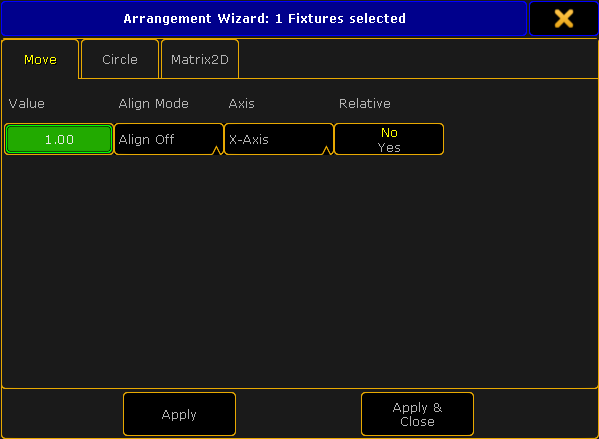
This gives you the possibility to move a selection of fixtures.
There are four settings:
- Value:
This is the value that tells you how far you want to move the fixtures. A positive number usually moves things to the right or up (depending on your view position). A negative number moves the selection in the opposite direction. - Align Mode:
This is the usual Align options. This allows you to combine the move function with Align. - Axis:
This is the axis plane in which the fixtures will move. - Relative:
With this you can move the fixture to its relative position.
When you are happy with your settings you can tap the Apply button once or several times to keep moving the fixtures (relative). If you only want to move it once more and then close the pop-up you can use the Apply & Close button. If you are done moving or just want to close the pop-up without applying any new values you can use the big X in the upper right corner.
Circle
This is the circle view of the Arrangement Wizard:
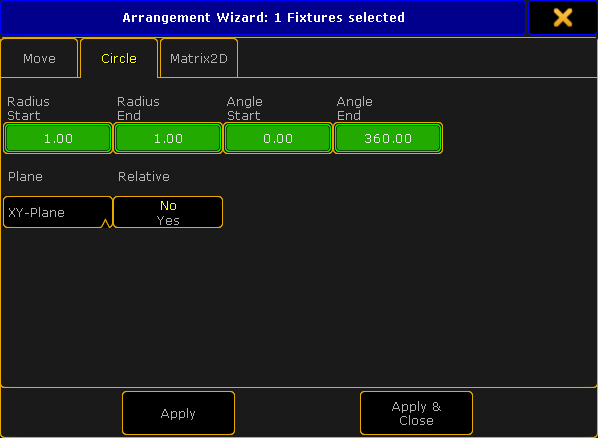
It can be used to arrange in circles or spirals.
There are six settings here.
- Radius Start:
This specifies the radius at the beginning of the circle. If this is different than the End radius the result will be a spiral. - Radius End:
This specifies the radius at the end of the circle. If this is different than the Start radius the result will be a spiral. - Angle Start:
Used to specify the beginning angle of the circle. - Angle End:
Used to specify the end angle of the circle. If the Start and End angle is not the same "degree" number then you will create arcs. - Plane:
With this you can choose in what (stage) plane your circle will be made. - Relative:
With this you expand your circle every time you tap the Apply button.
When you are happy with your settings you can tap the Apply button once or several times (and make the circle bigger with Relative on). If you only want to make one circle and then close the pop-up you can use the Apply & Close button. If you are done making circles or just want to close the pop-up without applying any new values you can use the big X in the upper right corner.
Matrix
This is the Matrix view of the Arrangement Wizard:
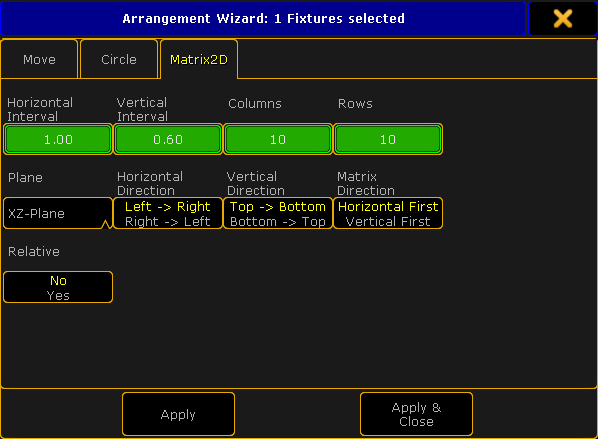
With this you can arrange your selected fixtures in columns and rows. There are nine settings here.
- Horizontal Interval:
This specifies the horizontal width between the fixtures (depending on your point of view). - Vertical Interval:
This specifies the vertical width between the fixtures (depending on your view). - Columns:
Here you set the number of columns you want. - Rows:
Here you set the number of rows you want. - Plane:
With this you can choose the plane in which your matrix will be created. - Horizontal Direction:
With this you can change the horizontal direction your fixtures should be placed in. - Vertical Direction:
With this you can change the vertical direction your fixtures should be placed in. - Matrix Direction:
Here you can chose if it should place fixture horizontal or vertical first. - Relative:
With this you can expand your matrix every time you tap the Apply button.
When you are happy with your settings you can tap the Apply button once or several times (and make the matrix bigger with Relative on). If you only want to make one matrix and then close the pop-up you can use the Apply & Close button. If you are done making matrixes or just want to close the pop-up without applying any new values you can use the big X in the upper right corner.
Layers in setup
You can also position and rotate the fixtures in the EditSetup or LiveSetup.
In the menu you need to select the layer containing the fixtures you want to position. Then scroll the right side almost all the way to the right. Here you'll find position and rotation XYZ values for each fixture.
Fixture positions window
In both EditSetup and LiveSetup you'll find a button on the right side called Fixture Positions. Tapping this (or the U2 key if the view is on screen 1) will open the Fixture Positions pop-up.
It could look like this:
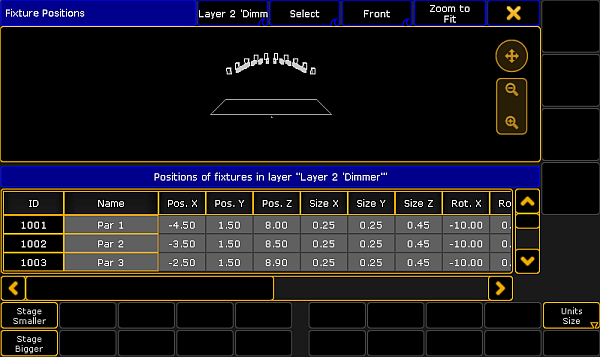
The top half works a lot like the Stage View. Although there is an extra swipe button in the title bar.
This is a layer selection. Swiping this will show you all the layers in your setup, but it will also include a layer with all the "3D objects".
The default is that there is always a "Stage plane" and a non-editable "Stage Markers". If you have added 3D elements in your show file then they will also be listed here.
The "all layers" does not include the 3D objects only the fixtures in your Patch & Fixture schedule.
Below the stage area is a list of all the fixtures/objects in the selected layer. This is used to arrange the fixtures/objects in a 3D environment.
Each line is a fixture/object.
There are several columns:
ID:
This is the ID of the fixtures. If the Channel ID and Fixture ID is not identical, then it displays the Fixture ID and then the Channel ID.
Name:
This is the name of the fixture.
Pos. X, Pos. Y, Pos. Z:
These cells are used to move the fixture in the 3D environment.
Size X, Size Y, Size Z:
These cells are used to change the physical size of the fixture.
Rot. X, Rot. Y, Rot. Z:
These cells are used to rotate the fixtures in the 3D environment.
Visible in 3D:
If this is "Yes" then you can see the fixture in MA 3D. Empty cell is the same as "No" and then the fixture/object will be hidden in MA 3D.
Sunshade:
If this is "On" then the Sunshade function in the MA 3D visualizer is active. This has to do with the object casting shadows.
Follow Target:
If this is "On" then the Follow Target function in the MA 3D visualizer is active. This has to do with the Follow function in the Stage view. It is relevant for 3D stage elements.
Model:
Here you can see and change the model used for the fixture/object. Editing this cell will open the small select Model pop-up. It could look like this:
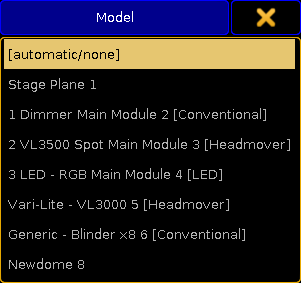
If you have custom models for your fixtures then you need to import them into your show (in MA 3D) and then select the imported model here for the relevant fixtures.
At the bottom part of the Fixture Positions pop-up there are three buttons:
Stage Smaller, Stage Bigger:
These two buttons are used to change the relationship between the stage area and the fixture/object list.
Unit:
This toggles between Size and Scale. The size is in meters. Scale is based on the model information.
This is a User setting and can also be changed in Setup -> User -> Settings. Here it is called "3D Item Units".
When the Fixture Positions pop-up is visible then you also have the same Encoder Toolbar as when you are using the Stage view to edit the position (read above).
Edit Fixture
Editing a fixture gives you the same position and rotation XYZ options as the using the EditSetup and LiveSetup layer view (read above).


